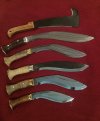Howdy folks.
I scored a DOTD WWII last month, about 18.5” and 28oz with a horn handle. I know there are MUCH heavier khuks from HI and some that are longer, but i can’t see any need for a bigger one anytime soon. I am pretty sure I want #2 to be lighter if not a bit shorter, and I think I would prefer a wood handle and different kami if possible (mine is Ram Kumar), just for variety. I am thinking maybe a villager/VUK or Tamang knife would be cool, but a Sirupati or Chainpuri (what’s the difference?) might also be good. How much lighter makes a worthwhile difference? I know quite a few of the knives I mentioned can come in around a pound to 20oz or so. Any thoughts?
Not super related, but one thing I have found in my few months of ogling khukuries is that the nomenclature and best use is unclear. Outside of the very light and/or small compared to the large and particularly heavy, there doesn’t seem to be a lot that differentiates the various styles. HI is better than most in that there aren't 100 different choices, but even the HI menu is confusing. To me, my WWII looks about the same as most Sirupatis (obviously not the really long skinny ones). Something all khukuri vendors, including HI, could do better in my opinion is make it more obvious why you would pick one over another. It would also be good to spell out what makes the seemingly similar types different and why that matters or if it is just style/personal taste.
Anyhoo, what do you think is a smart choice for #2? Also, am I correct in thinking that the HI faithful buy pretty much all of their knives here as special offers or DOTDs? BTW, if this belongs in the cantina please feel free to move it…
Thanks, Doug

I scored a DOTD WWII last month, about 18.5” and 28oz with a horn handle. I know there are MUCH heavier khuks from HI and some that are longer, but i can’t see any need for a bigger one anytime soon. I am pretty sure I want #2 to be lighter if not a bit shorter, and I think I would prefer a wood handle and different kami if possible (mine is Ram Kumar), just for variety. I am thinking maybe a villager/VUK or Tamang knife would be cool, but a Sirupati or Chainpuri (what’s the difference?) might also be good. How much lighter makes a worthwhile difference? I know quite a few of the knives I mentioned can come in around a pound to 20oz or so. Any thoughts?
Not super related, but one thing I have found in my few months of ogling khukuries is that the nomenclature and best use is unclear. Outside of the very light and/or small compared to the large and particularly heavy, there doesn’t seem to be a lot that differentiates the various styles. HI is better than most in that there aren't 100 different choices, but even the HI menu is confusing. To me, my WWII looks about the same as most Sirupatis (obviously not the really long skinny ones). Something all khukuri vendors, including HI, could do better in my opinion is make it more obvious why you would pick one over another. It would also be good to spell out what makes the seemingly similar types different and why that matters or if it is just style/personal taste.
Anyhoo, what do you think is a smart choice for #2? Also, am I correct in thinking that the HI faithful buy pretty much all of their knives here as special offers or DOTDs? BTW, if this belongs in the cantina please feel free to move it…
Thanks, Doug




